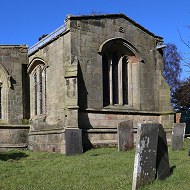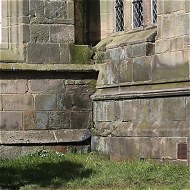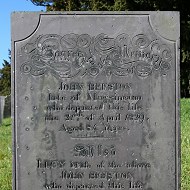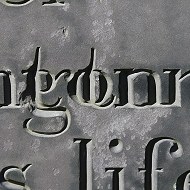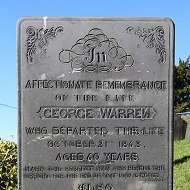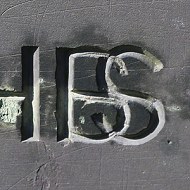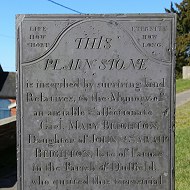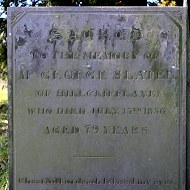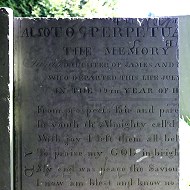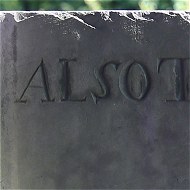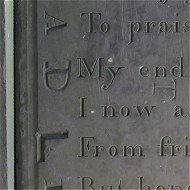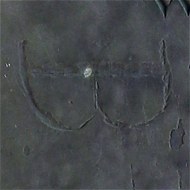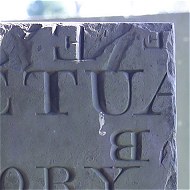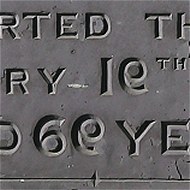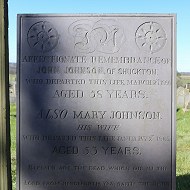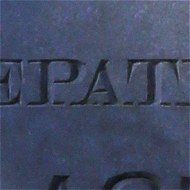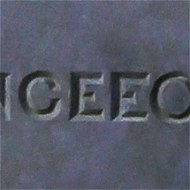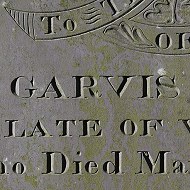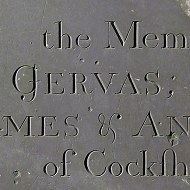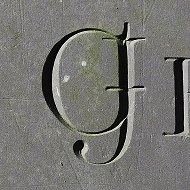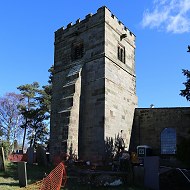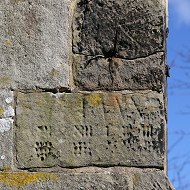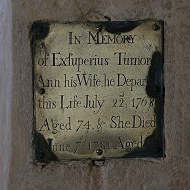Poor Frank Raw

Home | Why PoorFrankRaw? | Contact | Shop
All Saints, Mugginton, Derbyshire
08/03/2016: (Being renovated). I am not an architect and I claim no expertise in the merits, styles or periods of church architecture. However, you don't have to be a cabinet maker to know that your table has a wonky leg. The outside of All Saints, Mugginton looks like someone has taken a south aisle from a different church and slammed it into the side of the nave. In a hurry. "Hang on, that window isn't quite right - don't worry, hack out a piece of the east wall of the aisle and it'll do." Had a builder done a job like that on my place I'd have chased him round the block with a hammer.
None of the lines on the new (14C) aisle line up with anything on the nave. The nave window would be partly obscured by the new east wall of the aisle, so they chopped in a chamfer to allow partial light into the existing window. The aisle roofline is higher than that of the nave... I repeat, I'm no expert, but the phrase dog's-dinner comes to mind. The Victorians carried out some renovation work in 1841 and 1862 so some of these issues may have been introduced at that time, but this is an odd looking building. Currently the builders are in, relaying floors (gradients instead of steps) and adding a new servery and a disabled toilet. As a result it would be unfair to comment generally on how the church looks inside, due to the inevitable builders' mess.
The village is nowadays called Mugginton, but various web pages mention it with another 'g' - Muggington. The letter carver who prepared John Beeston's headstone decided to cover both possibilities by using both spellings - one over the top of the other.
The letter cutter who prepared the headstone for George Warren did a respectable job... Apart from a couple of small glitches - a reversed N (the biggest one on the stone and right on the end of the name of the deceased) and a bit of a spelling mistake which had to be corrected.
Sometimes a headstone catches the eye not because it has errors, or is brash and gaudy, or involves someone of historical interest, but because it is simple, well worded and conveys the emotions of the family left behind. One such is the headstone for the 7 year old Mary Beighton. "This plain stone is inscribed by surviving kind relatives, to the memory of an amiable and affectionate girl".
In July 1856 George Slater died. His headstone is plain, simple, conveys the dates and names we expect, a doggerel verse at the bottom and very little adornment. The front is unexceptional in every way. The back, however, raises a few questions which we can't answer. The piece of slate appears to have been cut down from a larger headstone - unfortunately the date and full name have been truncated. The original wording looks perfectly ordinary - well cut, no gross errors, so we don't know why it was either never erected or erected and then retrieved to the letter cutters workshop.
Once back in the workshop it came in handy for the apprentice to try cutting some amateurish letters. Roman and san-serif letters have been cut all around the stone. They even attempted to add in a word to the original layout, adding "ALSO" in front of "TO PERPETUATE...". Then George Slater died and needed a headstone. Was George poor and his estate could not stretch to a fresh piece of slate? Was it expected that
Eliza Newbold outlived her husband Samuel by 19 years. We don't know if the joint headstone was prepared after she died, or if her details were added to the headstone already in place after Samuel died. The lettering on Eliza's part of the stone does show several errors, so it may have been cut by someone later. There are a number of reversed Ns and unusually a couple of reversed 9s.
The headstone for John and Mary Johnson is slightly roughly cut. He departed but she depated this life... The lettercarver had a momentary lapse of concentration during HENCEEORTH too.
During the 18th century at least two members of the Beard family were given the first name Jarvis/Gervas/Jervas, but the letter carvers (and perhaps the family) struggled to find a consistent spelling.
The west outer wall of the tower is propped up by a massive buttress, two thirds the height of the tower. When this was built the doorway in the west wall of the tower was blocked and in the 18th century a door inserted in the south wall of the tower. Only at the end of the 19th century was the arch between the belfry and the nave opened. On the side of the buttress at the south east corner of the chancel can be seen the remains of a sundial, cut into the stones. A rusted remnant of an iron gnomon is still in place. The numbers on the dial are in Roman numerals and patterns of dots.
When the builders have finished work inside and the place has been cleaned and rearranged I will return and add details of the memorials inside, but one caught my eye. A small engraved brass plaque, on a pillar between the nave and the south aisle to Exsuperius Turnor (and his wife Ann). St Oswald, Ashbourne has a headstone to an Exuperius Brown who died 24 years earlier.
